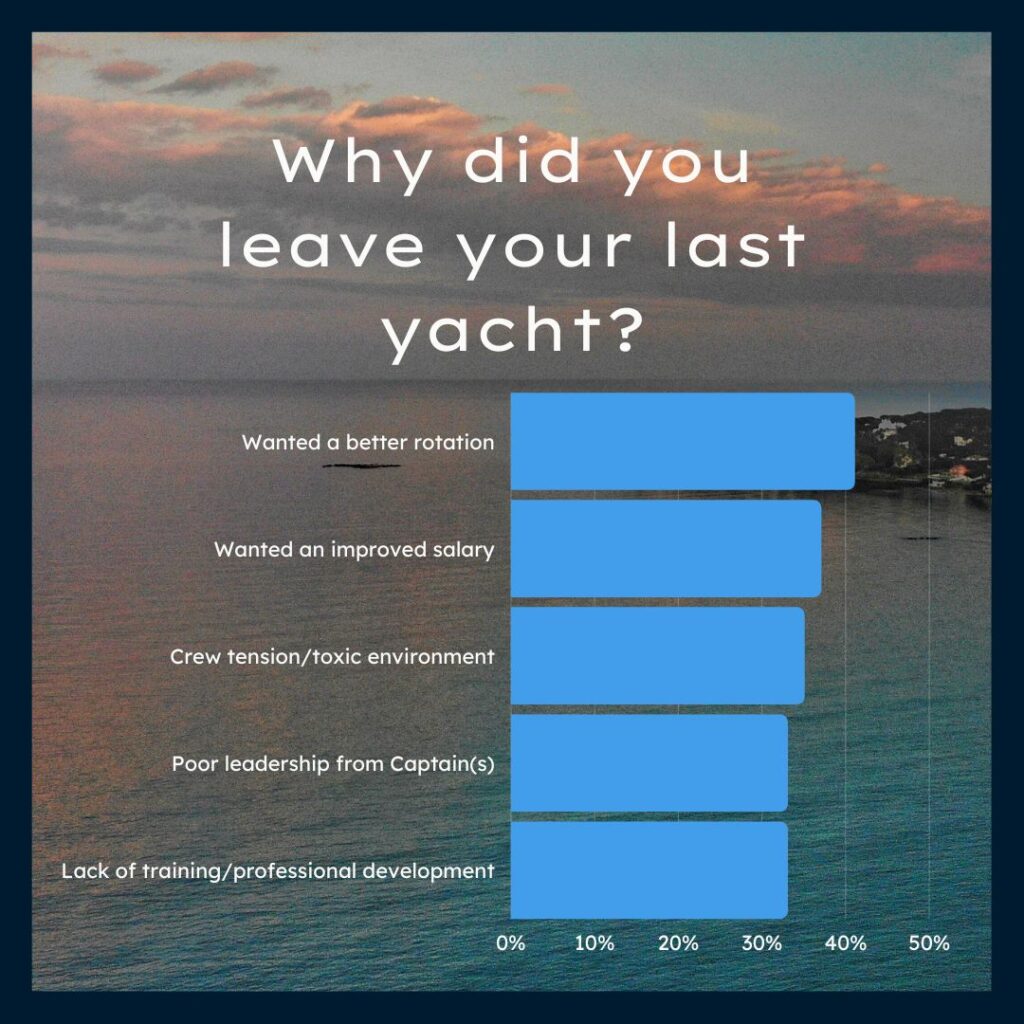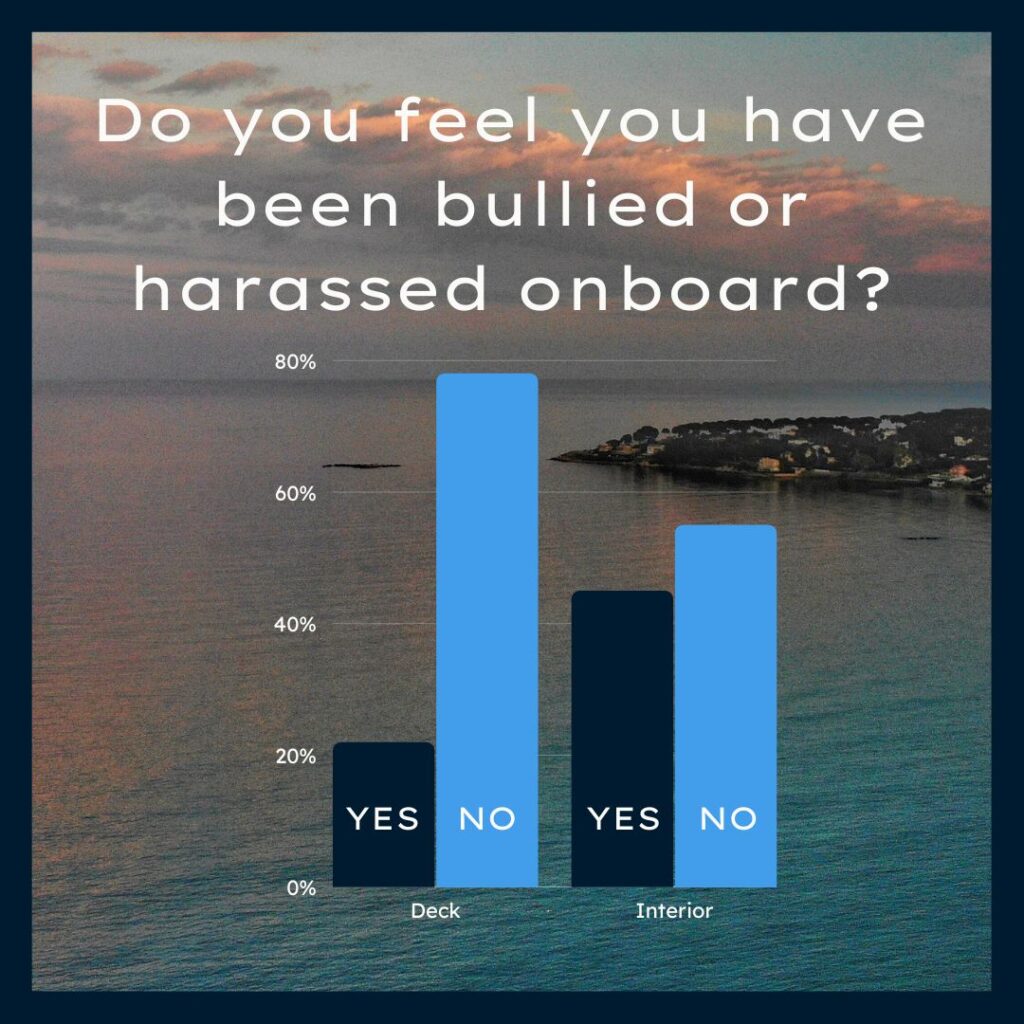In a recent survey of junior crew, we asked what factors made them leave a yacht and what would encourage them to stay onboard.
Crew retention is currently a huge focus in the superyacht sector and the findings reveal small changes that could help yachts keep hold of great candidates.
Three in five who responded are on deck, and two in five work in the interior department. All crew who responded have been working in the sector for three years or less, with just under half having 1-2 years’ experience.
Most junior crew (73%) have had one or two jobs in this time, but over a quarter (27%) have had three or more jobs.
Reasons for leaving a yacht
When asked what their reasons were for leaving their previous yacht, or why they would leave their current yacht if in their first role, wanting a better rotation came out on top (41%) followed by an improved salary (37%).

Given that the current average monthly salary of respondents is €3,167 and the desired salary is €3,461, it would suggest a c.€300 (10%) increase in pay could potentially encourage crew to stay onboard.
Almost half (47%) of junior crew are currently getting 45 days or less leave but 36% and 38% respectively want 60 days (5:1) or 3:1 rotation. Just 23% are on a 5:1 rotation in their current positions.
The findings also show that crew tension and a toxic environment is an important factor for 35% of junior crew, while poor leadership from Captains and lack of training and professional development was a reason for a third of those surveyed in equal measure.
Leadership of both Captains and HODs was ranked 6.2 out of 10 and of the one third of crew who have been bullied or harassed onboard, fellow crew in other departments are the worst culprits (33%), closely followed by HODs (29%) and Captains (25%).
Crew were also asked to rate the support for professional development, training and mentoring, which received 5.6 out of 10 and 5.9 for mental health support.
How can you retain crew?
Although improved leave and salary were the two most common reasons for crew leaving their last or current yacht overall, it’s actually being in a happy and positive working environment that would encourage them to stay put the most. Three quarters voted this as the top change they want to see onboard, followed by improved leave (71%), good training and career support package (64%) and a pay rise and/or bonus structure (54%).

Longevity
The survey findings suggest overall that very few crew spend even a year onboard one yacht.
More than two fifths (42%) of crew who have been in yachting less than 12 months have had two or more jobs.
In comparison, 62.5% of crew who have been in yachting 1-2 years have had two or more jobs and three quarters (75%) of those who have been in industry between 2 and 3 years have had three or more jobs.
The most junior crew members also have higher salary rise expectations for their next role than those who have been in yachting 13-24 months – 8.2% compared to 7%.
Salary expectations jump for those who have been in yachting for more than 2 years, to 15.4%.
How deck and interior differ?
When looking at the differences between onboard departments, 30% of junior deck crew average three or more jobs compared to 22% of interior junior crew.
The average salary of interior junior crew is 7% more on average than deckhands and their leave expectations are higher – 48% are looking for a minimum of 90 days/3:1 rotation or better in their next role compared to a smaller number (36%) of deckhands.
The main reason for leaving a previous role for deck crew was the pursuit of better rotation but for interior crew, it was because of poor leadership from the Captain(s).
More interestingly, the survey revealed that more than double the amount of interior crew feel they have been bullied or harassed onboard (45% vs 22%). Exactly half (50%) of stews who answered yes said they had been bullied by their HOD, with 42% citing fellow crew members.

Co-founder and Director, Tim Clarke, comments:
“The first thing that strikes me about the findings in this survey is the amount of jobs junior crew members have had in such a short time. The reality is, over a 3-year period, crew could easily have over a year off, because many crew do take huge chunks of time off between jobs. This could be to travel, do courses, take some downtime or wait for the right role, but rarely do crew go straight from one job to the next. So, when you look at the figures with that in mind, crew are spending far less than a year onboard.
“Another significant stat, although not particularly surprising in my opinion, is how more prevalent bullying and harassment is in the interior department. One of the shocking statistics to come out was that 50% of those who felt they had been bullied said it was their HOD doing the bullying. Anecdotally, this is something we come across time and time again and illustrates the clear need for more leadership training for HODs.
“There are probably some underperforming stews who may be confusing bullying with negative feedback regarding their work or performance too, and this should be considered.
“Overall, however, it does suggest that yachts need to do more to retain their junior crew, which will benefit them in the long-term.
“Whilst not every yacht can give better leave and more money, what has come out of the survey is the very average leadership scores given to Captains and HODs. This is therefore an obvious area where there is potential for vast improvement, via third-party training or self-improvement. This will result in a better working environment, reduced turnover and costs as well as an improved owner experience.”
If you would like access to the full report, please email marketing@quaycrew.com.





